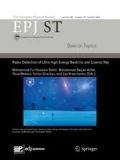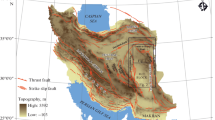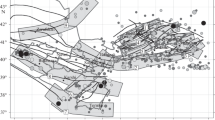Abstract
A network of vertical static pendulums (tiltmeters) has been in operation in Central Europe since July 2007. Hundred and eighty three seismic events of magnitude 7 and greater have occurred worldwide (EMSC) during the ten-year period. Several kinds of tilt anomalies were recognised within days up to months before the mainshocks. The most typical anomaly was a sudden tilting, parallel with the geologic structure, where the pendulum was installed. Based on the observations, we are proposing an asperity model, explaining the generation of so called “stress waves” before the mainshocks. Such stress waves of very low frequency (i.e. periods of days up to the first months) could be detected anywhere on the globe, especially on active geological structures, parallel with the fault, where a mainshock can happen. The observations suggest that we could estimate that part of the global fault system, which generates the detected stress wave, and which reaches the critical state. The estimation can be performed according to the amplitude of the stress wave, compared with stress waves detected on other structures of different orientations. According to the length of the stress wave (its period) and the tilt amplitude, it could be possible to estimate the magnitude of the mainshock.
Similar content being viewed by others
References
P. Bak, C. Tang, J. Geophys. Res. 94, 15635 (1989)
N.M. Beeler, D.A. Lockner, J. Geophys. Res. 108, 2391 (2003)
J.N. Brune, J. Geophys. Res. 73, 777 (1968)
S. Crampin, Y. Gao, A global earthquake monitoring system that would stress forecast all damaging earthquakes worldwide, in Proc. of ISESEP, 8th July, 2009, Beijing (2009). www.geos.ed.ac.uk/homes/scrampin/opinion
A. Douglas, J.A. Hudson, R.G. Pearce, Bull. Seismol. Soc. Am. 78, 1367 (1988)
Pendulum network data: dynamicgravity (2018), http://www.dynamicgravity.org/mereni/
K. Eftaxias, P. Kapiris, J. Polygiannakis, A. Peratzakis, J. Kopanas, G. Antonopoulos, D. Rigas, Nat. Hazards Earth Syst. Sci. 3, 217 (2003)
R.J. Geller, D.D. Jackson, Y.Y. Kagan, F. Mulargia, Science 275, 1616 (1997)
K. Holub, P. Kalenda, J. Rušajová, Terr. Atmos. Ocean. Sci. 24, 933 (2013)
V. Jirásek, O dolován černého uhl v oblasti Rtyňsko-Bohdašnské na Jestřebch horách (Rtyně v Podkrkonoš, 2012), p. 186
P. Kalenda, I. Pompura, Acta Montana 102, 145 (1997)
P. Kalenda, L. Neumann, I. Wandrol, Indirect stress measurement by static vertical pendulum, in Proc. of 47th Int. Sci. Conf. Experimentáln analýza napět (TU, Liberec, 2009), pp. 120–128
P. Kalenda, L. Neumann, Static vertical pendulum – observations of anomalous tilt before earthquakes (case study), in Rock stress and earthquakes, edited by F. Xie (2010), pp. 795–803
P. Kalenda, L. Neumann, J. Málek, L. Skalský, V. Procházka, L. Ostřihanský, T. Kopf, I. Wandrol, Tilts, global tectonics and earthquake prediction (SWB, London, 2012), p. 247
P. Kalenda, D. Ouzounov, V. Bobrovskiy, L. Neumann, O. Boborykina, A. Nazarevych, S. Šebela, J. Kvetko, W.-B. Shen, Geophys. Res. Abstr. 15 (2013)
P. Kalenda, K. Holub, J. Rušajová, L. Neumann, NCGT 1, 38 (2013b)
P. Kalenda, D. Ouzounov, Geophys. Res. Abstr. 16 (2014)
P. Kalenda, D. Ouzounov, V. Bobrovskiy, L. Neumann, O. Boborykina, A. Nazarevych, S. Šebela, J. Kvetko, W.-B. Shen, Multiparameter observations of precursors before strong earthquakes, in Proc. Of International Scientific Spring (March 10–14, 2014), Islamabad, Pakistan (2014)
P. Kalenda, I. Wandrol, K. Holub, J. Rušajová, TAO 26, 103 (2015)
P. Kalenda, L. Neumann, D. Ouzounov, The precursors before the strongest earthquakes 2007–2015 show: an effective short-term prediction is a real scientific goal, in Proc, in Proc. Of International Conference of Geoethics 2015 Prague – Přbram – Prague October 9 – 19 (2015)
P. Kolnský, J. Valenta, R. Gaždová, Acta Geodyn. Geomater. 9, 191 (2012)
T. Lay, T.C. Wallace, Modern global seismology (Academic Press, San Diego, 1995), p. 521
P. Mandal, B.K. Rastogi, R.K. Chadha, H.V.S. Satyanarayana, S.P.C. Sarma, N. Kumar, Ch Satyamurthy, P.I. Raju, N.A. Rao, Method of short term forecasting of moderate size earthquakes, US Patent No. 6728640 (2004)
V.I. Mjachkin, W.F. Brace, G.A. Sobolev, J.H. Dieterich, PAGEOPH 113, 169 (1975)
L. Neumann, P. Kalenda, Static vertical pendulum – apparatus for in-situ relative stress measurement, in Rock Stress and Earthquakes, edited by F. Xie (2010), pp. 255–261
F. Qian, B. Zhao, W. Qian, J. Zhao, S.-G. He, H.-K. Zhang, S.-Y. Li, S.-K. Li, G.-L. Yan, Ch-M Wang, Z.-K. Sun, D.-N. Zhang, J. Lu, P. Zhang, G.-J. Yang, J.-L. Sun, Ch-S Guo, Y.-X. Tang, J.-M. Xu, K.-T. Xia, H. Ju, B.-H. Yin, M. Li, D.-S. Yang, W.-L. Qi, T.-M. He, H.-P. Guan, Y.-L. Zhao, Sci. Chin. Ser. D: Earth Sci. 52, 1572 (2009)
D. Ouzounov, K. Hattori, P. Kalenda, W.-B. Shen, V. Bobrovkiy, M. Kafatos, Monitoring mega earthquake disasters by integrating multi-parameter and multi-sensors observation from ground and space, in APSCO Third International Symposium on Earth Quake Monitoring and Early Warning by Using Space Technology, 13–15 September 2011 (Friendship Hotel Beijing, China, 2011)
D. Ouzounov, S. Pulinets, K. Hattori, L. Lee, J.Y. Liu, P. Kalenda, Multi-sensor observation of pre-earthquake signals and their connection with major seismicity (IUGG, 2015). Abstract IUGG-2669
T. Rikitake, Earthquake Prediction (Elsevier Scientific Pub, Amsterdam, Netherlands, 1976)
Ch Scholz, L.R. Syke, Y.P. Aggarwal, Science 181, 803 (1973)
A. Sornette, D. Sornette, Europhys. Lett. 9, 197 (1989)
I. Tsubokawa, J. Geod. Soc. Jpn. 19, 116 (1973)
I. Wandrol, Modelling of mechanical behavior of the Earth’s crust (Ostrava, 2017), p. 160. Dissertation thesis. VŠB - Technical University of Ostrava, Faculty of Mechanical Engineering. Advisor Karel Frydrýšek
S. Wei, Eng. Sci. 9, 7 (2007)
M. Wyss, A.C. Johnston, F.W. Klein, Nature 289, 231 (1981)
Author information
Authors and Affiliations
Corresponding author
Additional information
Publisher’s Note
The EPJ Publishers remain neutral with regard to jurisdictional claims in published maps and institutional affiliations.
Rights and permissions
About this article
Cite this article
Kalenda, P., Neumann, L. Nonlinear stress wave generation model as an earthquake precursor. Eur. Phys. J. Spec. Top. 230, 353–365 (2021). https://doi.org/10.1140/epjst/e2020-000256-9
Received:
Accepted:
Published:
Issue Date:
DOI: https://doi.org/10.1140/epjst/e2020-000256-9




